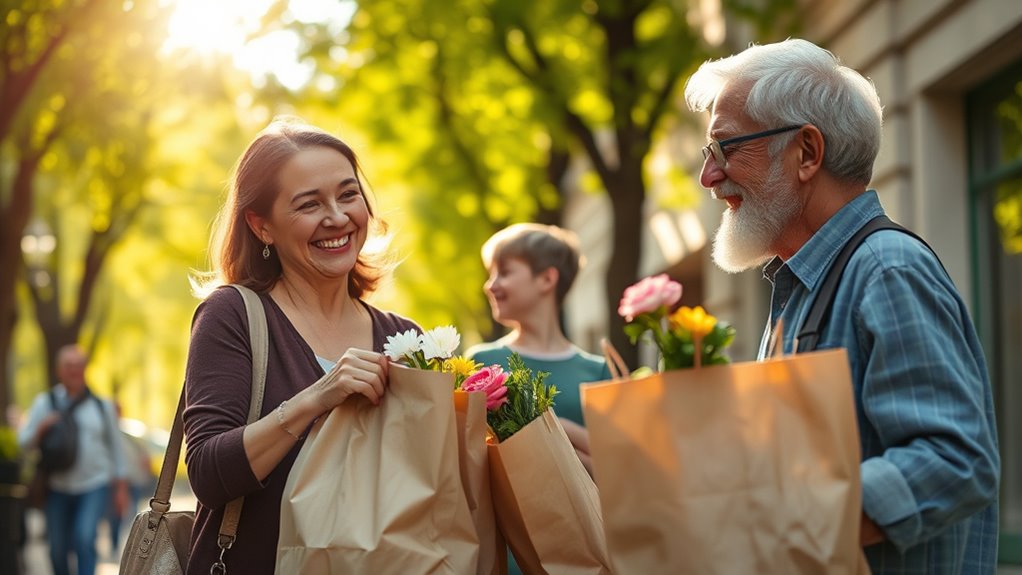Every small act of kindness you make can trigger an incredible ripple effect, inspiring others to do the same. Simple gestures like a genuine compliment or anonymous support can plant seeds of goodwill that grow far beyond your immediate circle. This cycle of kindness encourages a community built on trust, generosity, and compassion. By understanding how these actions spread positivity, you’ll discover how your small deeds can create lasting change. Keep going, and you’ll see how far kindness can truly reach.
Key Takeaways
- Small acts of kindness can trigger a chain reaction, inspiring others to pass on goodwill and support.
- Genuine gratitude and anonymous gestures amplify the ripple effect, fostering a culture of compassion.
- Acts of kindness, both visible and unseen, influence far beyond immediate recipients, shaping community values.
- The cycle of kindness encourages ongoing generosity, creating a sustained movement of positive change.
- Building a community through consistent, sincere acts helps expand the impact of individual good deeds.

Have you ever experienced how a small act of kindness can set off a powerful chain reaction? It’s amazing how a simple gesture, like holding the door open or complimenting someone, can spark a series of positive events. When you show gratitude expressions—sincerely thanking someone or acknowledging their effort—you not only brighten their day but also encourage them to pass that kindness along. Sometimes, these acts happen anonymously, without expecting recognition or reward. Maybe you leave a kind note on a coworker’s desk or pay for the coffee of the person behind you in line, without revealing your identity. These anonymous gestures might seem insignificant, but they plant seeds of goodwill that grow beyond your immediate reach.
A small act of kindness can trigger a powerful chain reaction of goodwill.
By engaging in small acts of kindness, you create a ripple effect. When someone receives your gratitude expressions, they often feel appreciated and motivated to help others, continuing the cycle. For example, after someone thanks you genuinely, you might feel inspired to do something kind for someone else. That person, in turn, may choose to pass on the kindness, perhaps by volunteering or offering support to a friend. It’s like a wave that spreads outward, touching lives you might never even meet. The beauty of this process is that it doesn’t require grand gestures; it’s about consistency and sincerity. A kind word or a thoughtful action can be the catalyst for a larger movement of compassion.
Anonymous gestures, in particular, have a unique power. They eliminate the need for recognition, focusing purely on the act itself. When you do something kind without expecting anything in return, you foster genuine generosity. This selfless giving often encourages others to act similarly, creating a culture of kindness that can grow exponentially. These acts of kindness might be small—leaving a note of encouragement or donating anonymously—but their impact can be profound. They remind people that kindness doesn’t always need to be public or praised; often, the most meaningful gestures are those done quietly and without fanfare. Additionally, understanding the importance of genuine relationship repair can motivate individuals to perform acts of kindness that help rebuild trust and connection.
Ultimately, the chain reaction of kindness is about more than individual acts; it’s about building a community rooted in compassion. When you take the initiative to express gratitude or perform anonymous gestures, you become a crucial link in that chain. Your actions might seem minor, but their influence can reach far beyond what you see. So next time you’re tempted to do something kind, remember that even the smallest gesture can ignite a wave of goodness that touches countless lives, shaping a more caring world, one act at a time.
Frequently Asked Questions
How Long Does a Kindness Chain Typically Last?
A kindness chain can last anywhere from a day to weeks, depending on generosity patterns and social influence. When you perform a good deed, it often inspires others to do the same, creating a ripple effect. Your actions can spark ongoing generosity, especially if others pass it along. The longevity of the chain depends on how consistently people are influenced by kindness, making it a powerful, lasting impact when the cycle continues.
Can Kindness Chains Occur Spontaneously or Only Intentionally?
Did you know that 70% of kindness chains begin with spontaneous acts? You can create kindness chains through spontaneous acts or intentional planning. Spontaneous acts happen naturally and unexpectedly, inspiring others without prior thought. In contrast, intentional planning involves deliberately organizing acts of kindness. Both types can spark powerful ripple effects, showing that kindness doesn’t always need preparation—sometimes, a simple spontaneous gesture can set off a meaningful chain reaction.
What Are Some Common Obstacles to Sustaining a Kindness Chain?
You might face obstacles like waning altruism motivation, where your initial desire to help fades over time. Social influence can also make it difficult to sustain a kindness chain if your environment discourages or doesn’t support ongoing acts. External pressures or fatigue might weaken your commitment, and without reinforcement, the chain could break. Recognizing these challenges helps you stay mindful and find ways to keep kindness flowing, despite these hurdles.
How Do Cultural Differences Influence Kindness Chain Reactions?
You might think kindness is universal, but cultural differences can dramatically shape how your acts of kindness are received. Cultural perspectives and social norms can turn a simple gesture into a powerful, world-changing event—or cause it to be misunderstood completely. In some cultures, kindness is shown openly, while in others, it’s more reserved. Understanding these differences helps you navigate social norms and create genuine, meaningful kindness chain reactions across diverse communities.
Are There Measurable Impacts of Kindness Chains on Communities?
You can see that kindness chains have measurable impacts on communities by boosting emotional well-being and strengthening social cohesion. When you participate in or witness these acts, you create a positive ripple effect that encourages others to do the same. This collective effort fosters a sense of belonging and trust, leading to healthier, more connected communities where people feel happier and more supported, making the overall environment more resilient and compassionate.
Conclusion
As you carry kindness forward, watch it weave a wonderful web of warmth and wonder. Your small act sparks a spectacular spiral, spreading smiles and strengthening bonds. Remember, one simple gesture can set off a stunning series of supportive surprises. So, step into the spotlight of generosity, and let your kindness create a mesmerizing cascade that continues to connect, comfort, and carry on. Together, you hold the power to ignite an inspiring, infinite kindness chain reaction.









